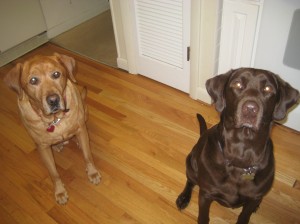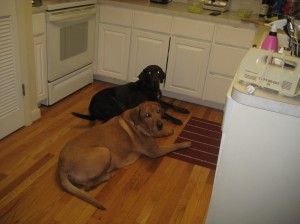There is no doubt in my mind that my dogs understand (at least in part) what I am saying to them; (which is why we say “W” for walk.) Just how many words a dog truly understands depends upon the researcher, I have heard anywhere from 160 words to over 250! I think there are some words that are very important for your dog to understand and these words will be your verbal commands. You may also want to combine your training with a non-verbal a.k.a hand signals or silent commands. If I have a hand signal for my command, I use the hand signal when I say the verbal. If you have been doing this, try not saying anything and just using the hand signal and see what your response is.
Just as there are varying opinions on how many words your pet understands, there are also varying opinions on what commands your dog should know. In my mind there are some that are very important and I would like to share those with you here and (in my opinion) how and when you should use them.
“Sit” – The most basic of the commands, and usually the easiest to teach, this means, “Put your butt on the floor/ground.” I use this command when I am feeding them; when someone is coming in the door, or when we are on walks and a car is approaching (with the hope that if for some reason my dog is EVER without me on the road, it will prevent him from getting hit by a car.) (Non-verbal is a closed fist.)
“Down” – The command means, “Lie down,” we use this for when we are eating dinner and we do not want the dogs sitting at our sides waiting for scraps of food. (Non-verbal is my hand palm side down, moving from about waist height down to hip level.)
“Stay” – This means “You sit or lie where I tell you to, and you stay there until I say you get up.” This command is important if you are bringing groceries into the house or putting them in the car and you don’t want your dog outside without you. (Non-verbal is hand palm side down, at about waist height.)
“Wait” – Similar to stay, with the exception being “You will be allowed to participate just not yet,” most times my dogs are in the car without their leashes, when I stop and want to take them out of the car, I tell them to “Wait” this command has prevented many dogs from dashing out a door and getting hit by a car. (Non-verbal is hand with the palm side facing the dogs; like a stop sign.)
“Place” – Our dogs lie on mats while we are eating dinner, we refer to these mats as “Place” when we sit down to eat we give each dog a treat, when we are done with dinner and they are released, we reward them each with a couple of carrots. Sampson is so conditioned sometimes when we take the plates out of the cupboard; he automatically goes to his “place.” Delilah hasn’t progressed that far yet. (I usually point with my finger and then say, “Stay” giving the hand command for stay.)
“Come” “Here” or “Front” – This command is a matter of preference, I use “Here” but my dogs will also respond to “Come.” This means, come back from wherever you are and whatever you are doing and “Check in” with me. Usually I am rewarding them for returning; especially if we are on the trail. (Non-verbal is me tapping the upper part of my chest a couple of times with my palm, sometimes I will just crook my finger at Sampson.)
“Ok!” – This is their release command, it means “We’re done” and you’re free to do whatever you want (within reason of course.) I usually clap my hands, give them rubbies and tell them “Good Job!”
“Crate” or “Kennel” – What it means is “Get in your crate,” my dogs spend very little time in their crate at this stage, but if you have a new puppy or dog, it is a good basic command to teach. What you call this is your personal preference, some people also say, “Kennel up.” (My hand signal is pointing into the crate.)
“Leash” – This means I need your leash on you, because I want you to stay with me. I do not (as of yet, have a non-verbal command for this.)
“Heel” – The command means you should come and sit by my side, most people heel their dogs on their left side but some heel to the right, depending on your preference and your dogs. I will slap my left hand against the side of my leg as my non-verbal command. Normally you would combine Heel with:
“Walk” or “With Me” – This means you will walk alongside me wherever we are going. I do not have a non-verbal for this.
“STOP” or “NO” – To me this is one of if not THE most important command, it means what it says, the way I taught Sampson was NO/STOP and directed him away from whatever it was he was doing (Delilah is still learning this one.) Once he got out of the car and saw a big black crow sitting in the road, his natural instinct was to go after it and he took off, but he did not see the car that was zooming down the hill; I screamed “Sampson, “STOP” and he put the skids on, and stopped himself just as his front feet hit the road. 🙂 I think this command saved my dog.
Of course you must find a word that you are comfortable with, that will also be easily remembered by both you and your pet. 🙂







Recent Comments